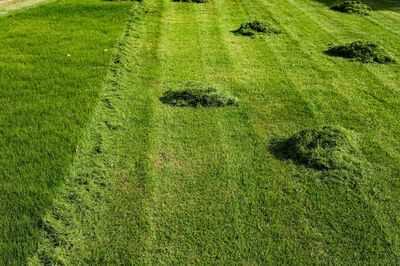
To maintain a healthy lawn, it is crucial to eliminate any moss that grows among the . With spring bringing new growth, moss can overtake a lawn, preventing nutrients and sunlight from reaching the ground.
Lawn expert Philip Voice, the brain behind Landscape Juice, has explained: "Sunlight is essential for photosynthesis to take place and if your grass has to work too hard, it will weaken and non-desirable grass species, as well as moss, can start to colonise the surface of your lawn." A lawn riddled with moss often suggests soaked soil with poor drainage.
READ MORE:
For those aiming for a lush green lawn sans the mossy invasion, it's necessary to aerate and scarify to avoid soil compaction. Philip disclosed: "Moss is often wrongly described as the cause of a poor lawn. Moss is, in fact, a result of having a poor lawn.
"The rule of thumb is, keep your root zone in good condition, improve overall growing conditions, and your grass will grow strongly, making it impossible for moss and weeds to compete."
Still, if your garden soil is in top shape and your lawn needs a nutrient pick-me-up, there's a simple fix, reports .
Philip suggested: "Good aeration is essential but sometimes you might need some chemical help to assist - a simple treatment is the application of sulphate of iron, to help suppress the moss.
"The common moss that is present in many lawns is Springy Moss; its properties are made up of over 90% water. Sulphate of iron will quickly expel the water and allow the grass to strengthen."
Iron sulphate works wonders by lowering the soil's pH, which makes the environment less welcoming for moss to take root on your lawn.
This compound not only saps moisture from moss to finish it off but also aids in facilitating grass growth by boosting chlorophyll production that allows the lawn to hoard more energy.
Aside from kicking moss to the curb, feeding your green space with iron sulphate can spruce up the colour, making it lush and green – perfect for when yellowing, patchy grass suggests an iron shortfall.
Phillip noted: "Even after as little as one hour, moss will start blackening; after two days, the moss content will have reduced and turned dark brown whilst the grass will have turned extremely green."
No need for complex treatments – just sprinkle your lawn with iron sulphate right after it rains to let the moisture work its magic in dissolving it. But remember to pick a calm day to do this task, steering clear of breezy that might unwittingly spread the substance to your other plants.
What you end up with is a fuss-free strategy to bid farewell to moss and keep your turf thriving, ensuring a flourishing, eye-catching lawn all through spring and summer.